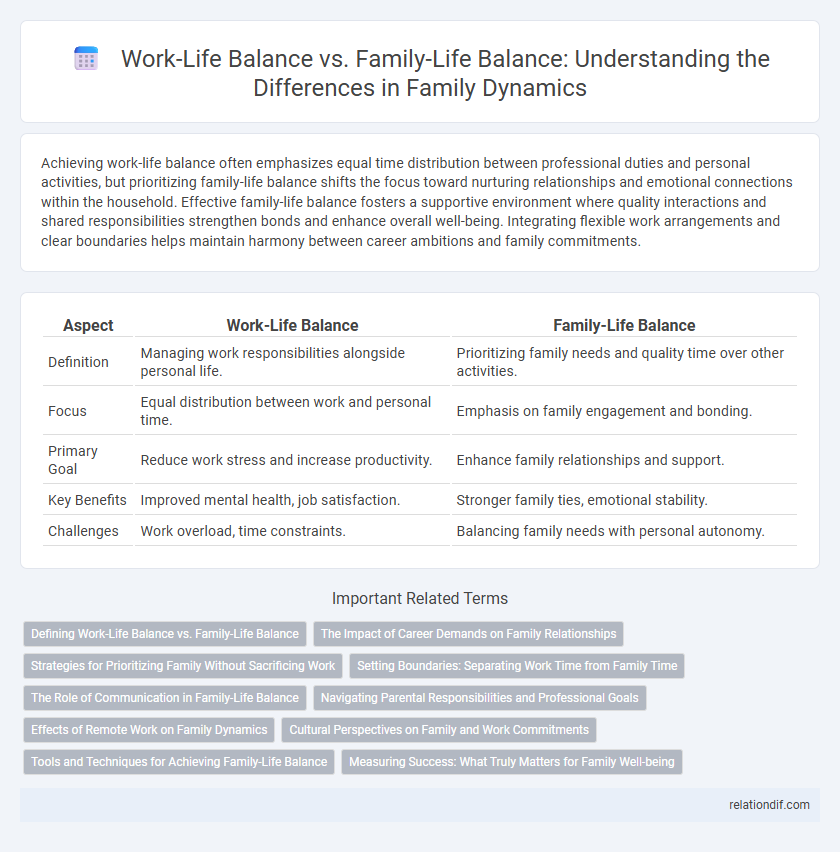Achieving work-life balance often emphasizes equal time distribution between professional duties and personal activities, but prioritizing family-life balance shifts the focus toward nurturing relationships and emotional connections within the household. Effective family-life balance fosters a supportive environment where quality interactions and shared responsibilities strengthen bonds and enhance overall well-being. Integrating flexible work arrangements and clear boundaries helps maintain harmony between career ambitions and family commitments.
Table of Comparison
| Aspect | Work-Life Balance | Family-Life Balance |
|---|---|---|
| Definition | Managing work responsibilities alongside personal life. | Prioritizing family needs and quality time over other activities. |
| Focus | Equal distribution between work and personal time. | Emphasis on family engagement and bonding. |
| Primary Goal | Reduce work stress and increase productivity. | Enhance family relationships and support. |
| Key Benefits | Improved mental health, job satisfaction. | Stronger family ties, emotional stability. |
| Challenges | Work overload, time constraints. | Balancing family needs with personal autonomy. |
Defining Work-Life Balance vs. Family-Life Balance
Work-life balance emphasizes managing professional responsibilities alongside personal time, whereas family-life balance prioritizes nurturing relationships and fulfilling roles within the family unit. Understanding the distinction helps individuals allocate time effectively to maintain career success while fostering family wellbeing. Achieving family-life balance often requires flexible work arrangements and clear communication to support both work demands and family commitments.
The Impact of Career Demands on Family Relationships
High career demands often lead to increased stress and reduced quality time with family members, negatively impacting emotional connections and overall relationship satisfaction. Balancing professional responsibilities with family commitments requires intentional time management and setting clear boundaries to prevent work from encroaching on family life. Persistent work-related pressures can contribute to conflicts and diminished support systems within the family unit, highlighting the importance of prioritizing family-life balance.
Strategies for Prioritizing Family Without Sacrificing Work
Effective strategies for prioritizing family without sacrificing work include setting clear boundaries between professional and personal time, such as designated work hours and family-focused activities. Utilizing flexible work arrangements like remote work or adjustable schedules can enhance family engagement while maintaining productivity. Prioritizing tasks and leveraging technology to streamline responsibilities enable professionals to maximize quality time with loved ones without compromising career goals.
Setting Boundaries: Separating Work Time from Family Time
Setting clear boundaries between work time and family time is essential for maintaining a healthy family-life balance. Designating specific hours for work and avoiding work-related tasks during family moments helps foster quality interactions and reduces stress. Consistent boundary-setting enhances emotional connection and ensures that family responsibilities receive the attention they deserve.
The Role of Communication in Family-Life Balance
Effective communication plays a pivotal role in achieving family-life balance by fostering understanding and cooperation among family members. Clear dialogue about schedules, responsibilities, and emotional needs helps prevent misunderstandings and reduces stress. Prioritizing open conversations creates a supportive environment that strengthens family bonds while managing individual commitments.
Navigating Parental Responsibilities and Professional Goals
Navigating parental responsibilities alongside professional goals requires intentional strategies to achieve work-life and family-life balance, emphasizing time management and prioritization. Effective communication with employers about flexible work arrangements supports meeting family needs without compromising career advancement. Leveraging technology for remote work and setting clear boundaries between work hours and family time enhances overall well-being and productivity.
Effects of Remote Work on Family Dynamics
Remote work significantly alters family dynamics by blurring the boundaries between work-life balance and family-life balance, often leading to increased time spent with family but also heightening the risk of work-related interruptions. Studies reveal that flexible schedules can improve parental involvement and child well-being, yet inadequate separation between professional and personal spaces may cause stress and disrupt family routines. Effective remote work policies that prioritize clear boundaries and communication are essential in optimizing family cohesion and maintaining mental health.
Cultural Perspectives on Family and Work Commitments
Cultural perspectives significantly influence the prioritization of work-life balance versus family-life balance, with collectivist societies often emphasizing family commitments over individual career goals. In many East Asian and Latin American cultures, strong family ties and obligations shape daily routines and decision-making, often leading to flexible work arrangements or extended family support networks. Western cultures typically advocate for a clearer boundary between professional responsibilities and family time, highlighting individual autonomy but sometimes challenging deep familial integration.
Tools and Techniques for Achieving Family-Life Balance
Effective tools for achieving family-life balance include time management apps, shared family calendars, and task delegation platforms that streamline scheduling and responsibilities. Techniques such as setting clear boundaries between work and home hours, practicing mindful communication, and prioritizing quality family activities enhance emotional connections and reduce stress. Utilizing technology alongside intentional routines fosters a harmonious environment where family needs are met without compromising personal or professional obligations.
Measuring Success: What Truly Matters for Family Well-being
Measuring success in family-life balance involves prioritizing quality time, emotional connections, and shared experiences over sheer productivity metrics common in work-life balance. Indicators such as reduced stress levels, effective communication, and mutual support within the family unit provide a clearer picture of well-being. Tools like family satisfaction surveys and time-use diaries help quantify these qualitative aspects, ensuring that well-being remains central in defining success.
Work-life balance vs Family-life balance Infographic

 relationdif.com
relationdif.com